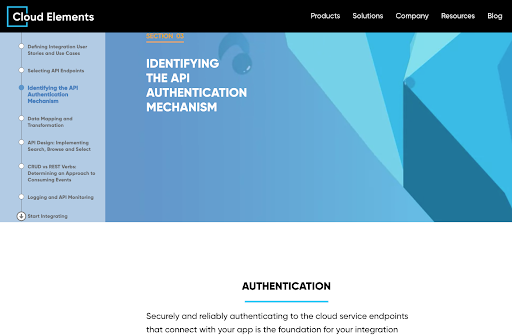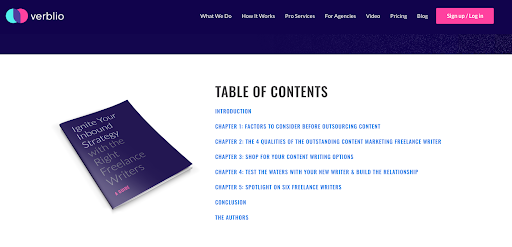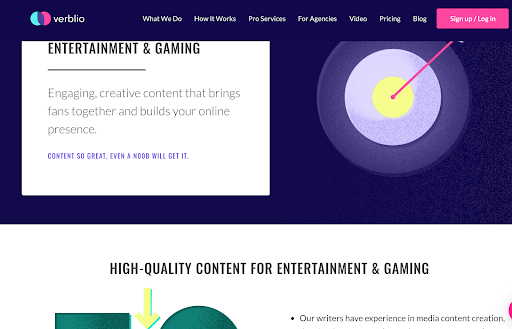Subscribe now and get the latest podcast releases delivered straight to your inbox.
A Little of This, A Little of That: Perfecting the Content Insourcing-Outsourcing Cocktail

By Kali Greff
Aug 6, 2019

Who writes the internet?
It’s a big question.Whether you’re looking at blog articles, social media posts, and even eBooks or pillar pages, way more often than not, it’s not who you think it is.
Even many of the most trusted thought leaders lean on a ghostwriter, or, at the very least, a cast of content talent to power the ship.
Heck, even AUTHORS of leather-bound books in libraries smelling of rich mahogany are using ghostwriters and editors.
Internet content is more like a collaboration of voices, carefully trained in brand experience, SEO, and marketing objectives, than anything else.
And it’s only getting increasingly that way.
More voices within organizations are stepping forward to represent brands; it’s not just marketers anymore!
Notably, subject-matter experts are surfacing through curated interviews and as guests on mediums like podcasts, so organizations are pulling deeper from their team’s benches to bring multifaceted brands to life through content.
Fluff by freelancers doesn’t cut it anymore. (But honestly...did it ever?)
The demand for quality
What’s driving this shift from freelancers to higher quality content by a choir of voices, husky and seasoned by experience?
It’s you, human readers of the internet! You demand it!
Simply put, search engines look to serve humans with more sophistication. We humans are becoming more discerning with what content we choose to consume and engage with.
Google and its competitors, in turn, are trying to make sure that the content they present to you to choose from is right on pitch.
Unfortunately, the quality of content from freelancers can be hit or miss. But here’s the rub about internal content creators as well: much of the most valuable knowledge is possessed by veterans further along in their careers, and most of those thought leaders haven’t focused on marketing or content creation anywhere in their career trajectory.
Furthermore, many of your experts may not be natural writers or might straight up be intimidated by writing.
So, how are these value-packed pieces by thought leaders, filled to the brim with mature, industry-specific knowledge, going to actually get written?
I assert this solution → a sweet, delicate balance of insourcing and outsourcing resources.
The perfect cocktail of insourcing & outsourcing
Believe it or not, a happy marriage of insourcing and outsourcing exists.
I say “delicate” because it can be fussy, and messy at times, but, as with most marriages (and cocktail recipes, for that matter), the combination and proportion of the parts is different for each set of individuals or company.
Before I get too much further, I will be open, transparent, and balanced (as will the rest of this post, frankly) and say I’m the senior content manager for Verblio, an outsourced content provider, and I wrestle with these sorts of questions every day.
You could call me the resident bartender for our own cocktail recipe.
So, I’ve got a whole host of learnings that I’m brimming with to share.
But first, a balanced exploration of insourcing and outsourcing content.
Insourcing is level-expert and the most effective, but can be damn hard.
Ramona, Liz, and Marcus Sheridan from IMPACT (plus many more content greats) preach the gospel of insourcing your own content as the hallmark of greatest success in content marketing.
And to take a quick step back — when I say insourcing, I mean exclusively writing content in-house.
With this I completely agree. Those are the most authentic, representative pieces of content your organization could possibly share. They showcase your deep bench of experts, allow you full brand control, and boost your brand’s credibility like woah.
And, if written strategically, these high-effort pieces can pay out in your inbound strategy for years and years.
A great example of insourced thought leadership comes from Cloud Elements, an API integration platform powered by HubSpot.
When you think about their audience and subject matter, you know they probably have to insource 99% of the time to ensure the accuracy and expertise of their content.
They tapped their plentiful internal resources to source their pillar-page-turned-interactive-resource Definitive Guide to API Integration.

Just not typically something the run-of-the-mill marketer, no matter how smart they are, would be able to complete, right?
This asset is so valuable (not to mention so juicy from an SEO perspective), partly because voices were brought forward in its making that typically aren’t included in marketing materials.
From the Verblio corner, a good example of insourcing for us was Verblio’s ebook “Ignite Your Inbound Strategy with the Right Freelance Writers,” which we wrote for the HubSpot Academy. Sourced by Verblio insiders on content marketing (one being yours truly).
This ebook, and now pillar page, is an agnostic exploration of exactly many of the questions of how to tackle content as I’m covering here.

It did require a two-week sprint for a couple of our FTEs internally and more than a little editing, but in setting aside the time for such an important project and drawing on our internal expertise in content marketing, we now have our most successful lead magnet running and sharing the downloaded knowledge from our brains with our audiences.
That said…
...the drawback:
Insourcing often meets one big, tall hurdle: buy-in at all levels.
The fact is: meaningful content comes from every corner of an organization — product people, developers, account managers, those seasoned veteran thought leaders. Looking at all of you!
Imagine convincing your boss or the busiest person in your company that they need to write a 1,000-word thought leadership, marketing piece about a topic they’re passionate about, or an answer to a FAQ the industry needs to know.
For some of us, it can be like asking this straight-shooter for help writing content:
Rallying ALL these folks around the value of content and the necessity of demonstrating deep knowledge in a given industry online through content is not easy.
It’s a task that requires advocacy with nearly boundless resilience.
At the least, it starts with a content manager or lead with that job description (overseeing/keeping your organization accountable to its content goals), and the ability to rally different parties and implement processes to motivate content creation.
This pain can walk and talk a little differently. We hear the following at Verblio, and fellow in-house content managers like Ramona personally can attest to some of these tell-tale signs:
- When content falls to the bottom of any team member’s to-do list (even that of a content manager!) for when “the mood strikes.” Perfectionism takes over, it never gets done
- Doubly true for those like CEOs or other exec/high-level employees who commit and want to write, but bite off more than they can chew and never can quite get to finish on the big thought-leadership piece
- When layers upon layers of compliance or organizational red tape or editing by committee strip away any interesting or juicy points of a content piece before it sees the light of day with publication
- When time management and poor content management interferes: without allotting time and outside accountability, many thought leaders argue they don't have the time to produce content
- Not everyone is a writer, which produces a content quality issue — then forces a content manager to go into hyperdrive to compensate with excessive editing, crafting concise thoughts around industry expertise
Now, let’s shake this up to the other side of this cocktail teeter-totter:
Oh, no, not shots, but…now that I have your attention...
Outsourcing!
Outsourcing is table-stakes and necessary, but damn it’s hard to get right.
Enlisting help through freelancing is oftentimes the only way marketers can get shit done.
How do you think so many marketers keep the lights on at their day jobs when they’re undergoing a major rebrand, building a new website, hosting an industry event, or any other major operational, branding, or company project?
(Hint: the answer isn’t hiring a bunch of temps.)
That’s where outsourcing comes in: that is, enlisting help of non-full-time employees (FTE), oftentimes freelancers or a vendor, for help getting development, design, marketing agencies, and copy/content written.
These outsourced freelancers and resources have no shortage of work in the digital economy.
The fact is that outsourcing is already part of daily content operations for nearly every business out there.
But, like insourcing, the common thread is that creating quality content is hard. No matter how you squeeze the lime or muddle the mint, it’s not like living in Margaritaville.
No, it’s like sipping on a “Death in the Gulf Stream” if you’re Hemingway experiencing writer’s block.
At a base, outsourcing requires a steady hand — for content, this means being well-versed in how content should walk and talk for a given brand, but that hand should also be an expert in the subject matter. It should be equipped and ready to gather and infuse in-house expertise into the pieces the writer creates. That’s crucial to nailing outsourcing.
Furthermore, they should be able to identify good content when they see it (seriously, it’s surprising how rare a skill this is!), facilitate efficient feedback loops, and produce and revise quickly.
When outsourcing goes extraordinarily well, companies like the e-commerce shop Wild West Pool Supplies can get quick help with 500+ product descriptions, then expand to blog posts and eventually long-form ebooks, all while only employing one FTE in-house!
The results speak for themselves: over the course of two years building and outsourcing content, they saw traffic for their otherwise modest site spike 4,452.94%. (Yes, that’s a percent.)
And it as all while retaining the same number of FTEs, and directly impacting their (and any business’) number one KPI: a boost in revenue.
Their conversions spiked 590.3%, and revenue is up more than five times from search engine visits alone.
As another example, Verblio recently enlisted help from our deep bench of subject-matter experts to capitalize on SEO traffic related to the 38 different industries we serve, from automotive to technical to entertainment — think keywords like “content creation for automotive” or “technical writing services.”
Our aims were two-fold:
- optimize for organic traffic-related to specific industries for big SEO gains, at scale, and
- bring forward our outsourced expert writers (no, not all industry knowledge has to come from insourcing ;)) and brand to speak to hyper-specific concerns and FAQs by industry.
Getting initial drafts of these long-form sales pages coming in at 1,200-2,000 words each and then coordinating design, subsequent brand/formatting edits, and polishing was absolutely crucial for me to keep the train on the tracks and keep this project barreling forward.

While incredibly powerful, outsourcing is one of those spicy organizational challenges that is really easy to think through negatives on. It just is!
But, like most organizational choices, if implemented sloppily, or not owned by one strong internal hand, the execution will easily fall short of expectations.
This list looks shockingly close to a list of sales objections we aim to overcome internally at Verblio :) That aside, they are all valid, very real problems that are inherent to the business of outsourcing. Let’s take a look:
- It’s often difficult to communicate needs to a freelancer and “speak the same language” of your business, as they are likely going to be unfamiliar with your brand and culture.
- It can be difficult to get a hold of them. On a related note...
- Freelancers may disappear into the sunset, never to return — many of us have been burned by the freelancer cowboys.
- You may encounter the over-communicative freelancer that requires more onboarding, training, and consultation sessions than it would take to just write the piece yourself.
- Scattershot quality can be rampant, even from a single freelancer.
- Frankly put, a freelancer is not in your company and may not have the first-hand experience and depth of industry expertise to get a high-quality piece of content right on the first try.
- Working with a freelancer might have the adverse effect of not streamlining your workflow.
Of course, it’s expected that onboarding a new person will always take longer at the beginning, but pay off later after they’re all trained up. However, if time spent communicating is not going down over time and momentum isn't picking up, you’ll need to reassess the relationship with a given freelancer or content solution.
How can they work together?
Now, you’ve got the spread. You know the ins and outs. I’ve done what a mediocre content marketer should do — given you the lay of the land.
But, with a balanced exploration of the issue at hand like this piece, as the reader you get shifted back and forth as you read. Which then begs the question from you: But...what am I supposed to do now?
I won’t leave you hanging. This isn’t one of those posts. Actionable content is the fuel to the fire for good content marketers.
If I had to label our cocktail recipe in-house at Verblio, I’d say it’s a stiff one, robust with insourced experience (it’s not a mocktail, y’all) and tempered with strategic, interesting mixers to keep it refreshing and full bodied with a wealth of perspectives.
Let’s call it a gin and tonic, maybe with a ginger twist (if I’m involved, you better bet that’s part of it!).
Here’s what I suggest you square away as necessary set-up for your content cocktail to shine and be positioned best for success, no matter the exact formula of insourcing/outsourcing mix that feels right to your organization or brand:
- Curate a content style guide! This resource will prove important no matter how you’re sourcing your content for aligning on organization, requirements, quality, examples of what to do/what not to do, language specifics, and also mechanics of how long is too long, linking conventions, formatting, etc. In-house and outsourced folks alike will thank you for this asset.
- Invest in developing quality outlines. The quality of prompts/outlines are JUST as important as drafts of content are themselves, in both insourcing and outsourcing. Getting good at outlining, conducting research (SEO & industry-wise), and training up freelancers accordingly has become a hallmark of those who can successfully delegate and kick ass at outsourcing.
- Take a little extra time to look for freelancers in the reputable places. Vetting them with a trial project to start is very important to finding the right outsourcing partners.
Fiverr is not the right place. Some right places can be: Facebook communities, platforms (Verblio is an obvious plug, but there are other good ones), and LinkedIn groups/recommendations.
Bottom line: Experimentation is the name of the game. Like any cocktail, you’ll need to try quite a few (with guinea pig projects) to test every cocktail and permutation of ingredients out in the wild.
My main advice? It’s not an either/or, all insourcing or all outsourcing.
It ain’t a mix if it’s just one or the other. Pilot some freelancers along the way to determine fit, and don’t overthink it if they complement your brand right away.
If you’re getting your feet beneath you, use your brightest minds and greatest writers to strategize and outline effectively, then outsource or pull in your content-savvy team members where you can.
If you are barely treading water, in-source whatever you can, but outsource more than that. Build toward a culture of insourcing, but make moves on your SEO or other organizational goals on content.
If you are drowning in the content waters, outsource (and perhaps work with a consultant). Don’t let perfection get in the way of productivity. Sit down and make an editorial calendar. Ask for help.
Over to you: what’s your insourced/outsourced cocktail recipes? Does it depend on the occasion? Industry? I’d love to nerd out with you on the perfect marriage you’ve found for your business or agency.
Also, the Verblio cocktail isn’t a house secret — I’d be more than happy to share more specifics on our own content workflow, or those of clients of ours, and how to run little experiments to make sure you’re getting your formula right and iterating as you learn lessons along the way.
Get in touch with me at kali@verblio.com. Cheers!


Order Your Copy of Marcus Sheridan's New Book — Endless Customers!